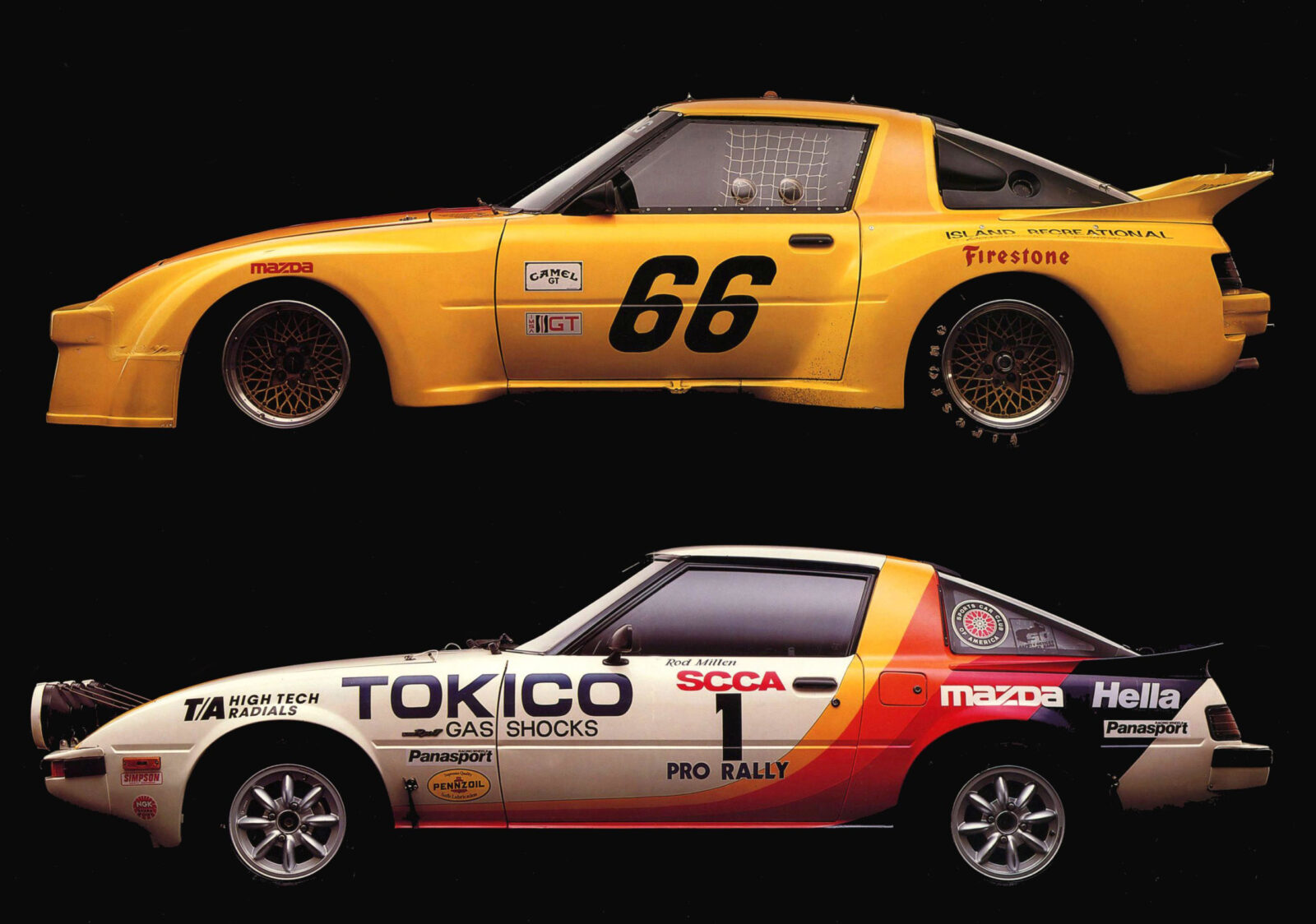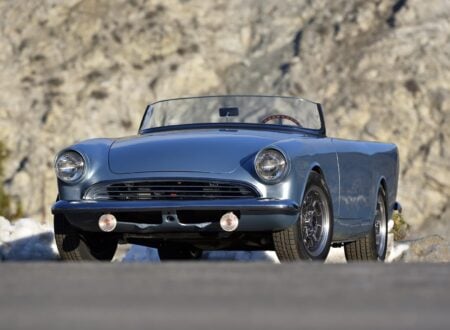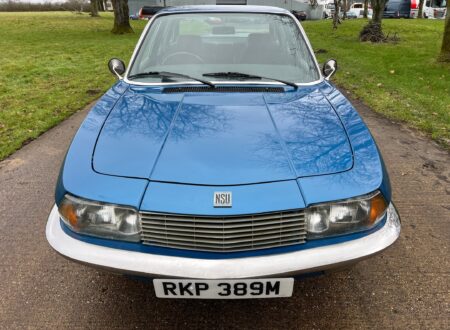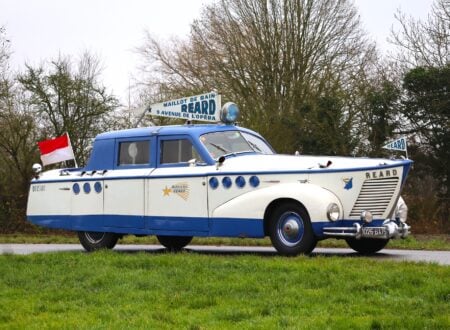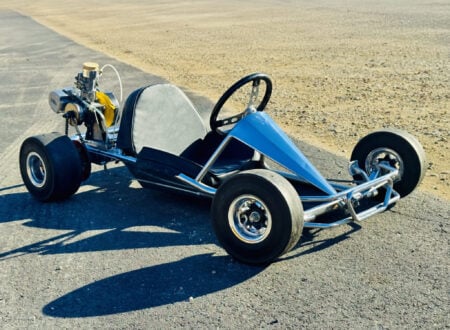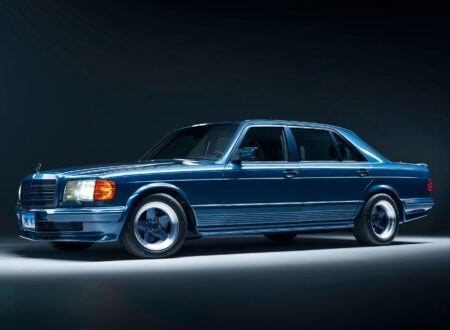The Mazda RX-7 – An Introduction
The Mazda RX-7 was the result of Toyo Kogyo Corporation’s high risk strategy of embracing the new and unproved Wankel engine technology with which to carve out a profile for themselves as a new technology innovator. Three automobile makers attempted this, NSU of Germany, Citroën of France, and Mazda of Japan. Of the three, the effort to bring Felix Wankel’s rotary engine up to regular production reliability broke NSU, almost broke Citroën, and proved to be the making of Mazda.
The single most critical technological hurdle in transforming the Wankel engine from an unreliable prototype into a dependable production engine was finding the solution to the rotor edge seal problem. Mazda’s engineers were the ones who hit upon the solution to the problem with the creation of their carbon-aluminum seals that ended the problem of rotor edge chatter which gouged the interior of the engine’s housing.
With their version of the Wankel engine viable for production Mazda needed a suitable “vehicle” in which to showcase it. NSU had made the mistake of bringing their Wankel engine into production before they had attained the sort of technological advances that Mazda had, and they compounded it by installing their engine in a rather ordinary sedan car, the NSU Ro80, and in doing so failed to showcase the technology in a remarkable way. The result of this was that buyers of boringly ordinary sedan cars bought cars with boringly ordinary piston engines: there was no incentive for them to gamble on a sedan with untried new technology.
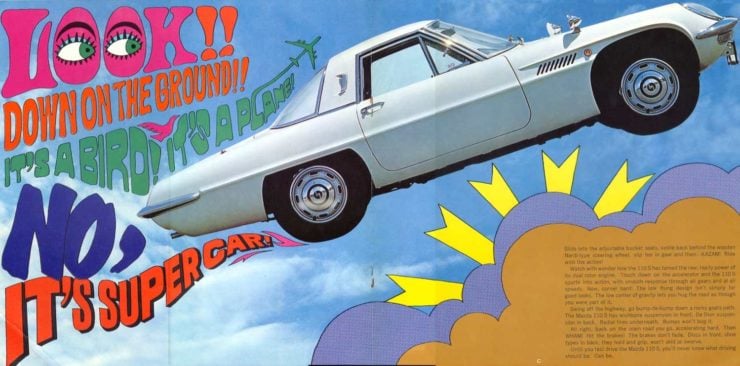
Mazda on the other hand decided to do what British car maker Jaguar had done when they first introduced their new DOHC XK engine after the Second World War: they installed it in a beautiful and exotic sports car, the Jaguar XK120. In 1961 Jaguar did it again, with that same XK engine, in the Jaguar E-Type.
So Mazda decided that they would showcase their Wankel rotary engine in a “space age” sports car, and that car was the Mazda Cosmo, first shown in 1964 at the Tokyo Motor Show but which was not allowed into regular production until May 30th, 1967, by which time it had been debugged with Japanese attention to detail.
The Mazda Cosmo was to be the company’s “halo car” and one of the strategies Mazda used to prove its reliability and speed was to enter two mildly modified Cosmo’s in the 84 hour Marathon de la Route at the famous Nürburgring race circuit in Germany. One car suffered an axle failure in the 82nd hour while the other completed the course and took a creditable fourth place. Mazda had proved the Wankel engine to be a great sports car engine and this led to them installing them in performance oriented cars.
The Mazda Cosmo remained in limited production until 1972 while Mazda also installed a Wankel engine in their small lightweight RX-3 Savannah coupe and it was campaigned in motor racing with great success. The RX-3 was a quite low cost performance car and it served to positively associate the Wankel engine with the Mazda name. All that was needed as the follow-up strategy was for Mazda to create an affordable mainstream production sports car with speed and style, powered by that unique Wankel rotary engine. They decided to build something of about the same size and similar style to the Lotus Elan: the RX-7 was born.
The First Generation Mazda RX-7 Savannah “SA22C” and FB
(Series 1 1978-1980, Series 2 1981-1983, Series 3 1984-1985)
The Mazda RX-7 continued the name “Savannah” that had been used for the small RX-3 sports coupe but it was a completely different car, the only thing in common with the RX-3 being the fact that the RX-7 was also fitted with a Mazda Wankel engine.
Designed by a team led by Matasaburo Maeda the new RX-7 went on sale alongside a couple of other Mazda rotary engined cars; the Mazda RX-5 Cosmo CD Series, which had followed on from the original Cosmo but which was a completely new design, and the Mazda Luce luxury sedan, which was often also marketed with a piston engine as the Mazda 929. So Mazda’s rotary line-up included the Cosmo CD coupe, the Luce luxury sedan, and the RX-7 Savannah as the Lotus Elan-like sports car.
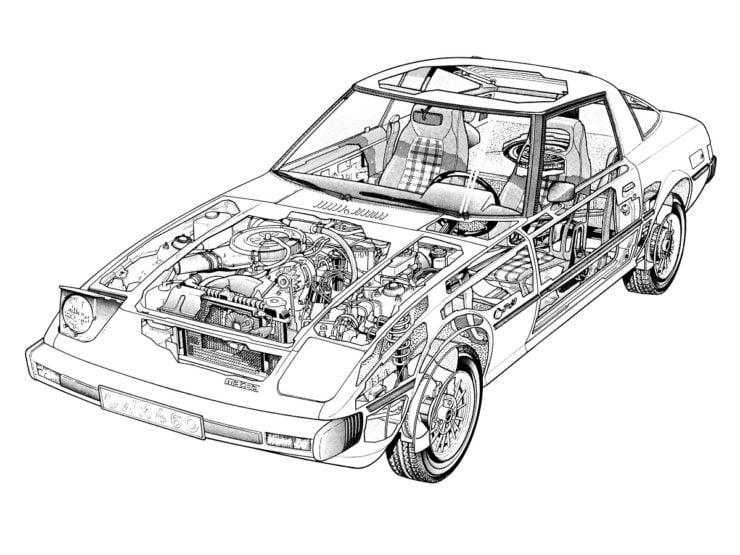
Mazda used safe and predictable conventional technology as much as possible in their new sports car. The front suspension was by McPherson Strut with anti-roll bar, one of the most common types used on Japanese cars, while at the rear was a beam axle supported by a quite complex four link system combined with a Watts Linkage, coil springs all around.
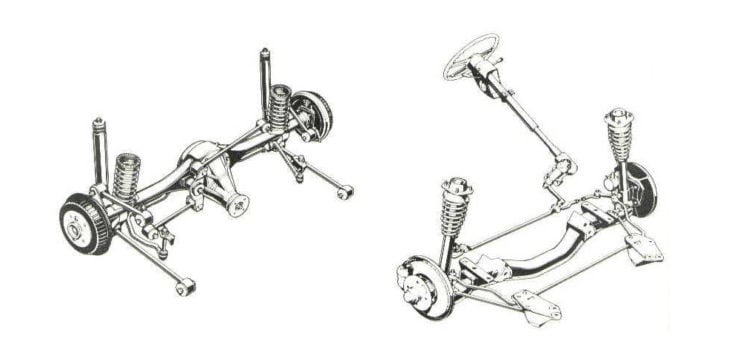
In typical Japanese style of the time the front brakes were discs while at the rear were drums. This served to keep the suspension and braking system familiar to most mechanics who would service it, and to provide the best handling possible while still retaining a beam axle at the rear. In line with this the common worm and roller steering system was used despite the fact that a rack and pinion system would have appealed to sports car purists much more.
To get the most out of this complex, but pretty conventional suspension the car would need as low a center of gravity as was feasible, and as close to a 50/50 front to rear weight distribution as possible. The compact size of the Wankel rotary engine was a great asset in achieving these aims. The smallness of the Wankel enabled its being fitted behind the front axle line, giving the RX-7 a “front mounted mid-engine” and thus achieving a near perfectly even front to rear weight distribution. The engine’s small physical size also permitted its being mounted low, thus keeping the center of gravity low.
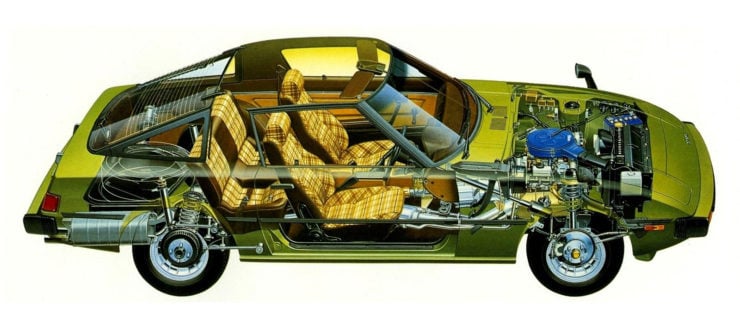
There were a few features of the Wankel rotary engine that attracted Mazda’s engineers and management to it, some of those features were technical advantages, and one was regulatory. The Wankel engine produces power out of proportion to its capacity. This means that a Wankel engine produces equivalent power to a reciprocating engine of much larger capacity. For a car this keeps weight down and allows for the use of a more compact engine space. But there is also a regulatory benefit in that the Wankel engine, having a smaller capacity, puts a car into a less expensive licensing category.
In Japan cars with an engine capacity below 1,500cc were exempt from the annual tax that applied to cars above 1,500cc. The RX-7 was fitted with a twin rotor 12A engine of 1,146 cc capacity, nicely inside of the Japanese 1,500cc limit (Note: each of the two rotors of the engine had a capacity of 573cc).
This 12A engine had technical advances that made it better than its Mazda predecessors. Earlier engines had used a sprayed metal coating in the rotor side-housing, a clever part of the solution to the edge chatter problem of early engines, and something that when combined with the use of carbon-aluminum edge seals had been the secret of making the Mazda Wankel engines viable for production.
The new 12A engine however did away with that original solution and instead used a Sheet metal Insertion Process (SIP) which involved a chrome plated sheet steel liner inserted into the rotor housing. The result of this was a rotor housing with a much harder and more durable inner surface, so hard in fact that the carbon-aluminum edge seals could be done away with and cast iron seals used in their stead.
The power output of the 12A engine was 100hp @ 6,000rpm and the early model of the RX-7 tipped the scales around 2,300lb (i.e. one metric tonne) and the aerodynamic body boasted a drag coefficient of just 0.36: so the RX-7 was all set to be a nippy little performer.
What would set it apart however would be the attribute of a Wankel engine that a piston engine does not share, a Wankel engine loves to rev at high speed, and it does it without the sort of problems that a reciprocating engine presents. The engine was given a redline of 7,000rpm and, because it would sound so happy revving its little six chambered heart out, was also given a warning buzzer to let the driver know that he or she needed to back off the throttle before the engine suffered a nasty and expensive mishap.
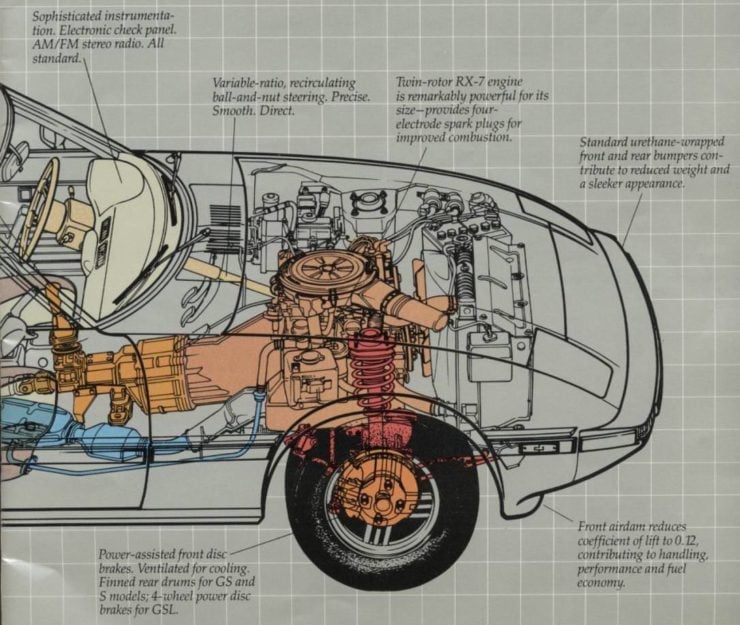
That first RX-7 was capable of a top speed of around 120mph (190 km/hr) and could do a standing to 60mph in 9.2 seconds. It was also capable of generating 0.779g in cornering, depending on the tires fitted, because of its low center of gravity and even weight distribution. These first generation cars can be found with either four or five speed manual transmission or a JATCO 3N71B three speed automatic.
The first generation cars were given an update in 1981 heralding in the Series 2 models. These Series 2 cars had some different styling features including plastic covered integrated bumpers and black rubber side moldings with wraparound tail-lights, styling features that would be carried on in the later Series 3.
The Series 2 models no longer had the four speed manual gearbox but were fitted with the five speed as standard. The fuel tank was increased in capacity and the interior was redesigned into a cosy yet businesslike environment. The speedometer was changed from 85mph to 130mph in 1983 with the removal of the 85mph speedometer limit that had been imposed by zealous US administrators seeming to think that “what you don’t know can’t hurt you”, i.e. “if your speedometer only goes up to 85mph then you won’t go any faster”. Americans were grateful that President Ronald Reagan saw the folly of the rule and helped remove it in 1981.
The RX-7 was offered in a number of option packages and the GSL package was offered in 1983. This provided four wheel disc brakes, and for hot and sunny Australia the front discs were ventilated: the package also included a clutch type limited slip differential. Because the US Department of Transportation mandated a 17 digit Vehicle Identification Number (VIN) system the Series 2 and Series 3 cars were given the FB designation in their VIN.
The power of the 12A engine was also increased slightly in the FB cars from 100hp to 114hp. In 1983 the Mazda RX-7 was included in Car and Driver magazine’s “Ten Best” list.

The final series for the First Generation RX-7 was the Series 3 which were introduced in 1984. The Series 3 cars would see the introduction of the GSL-SE option package for the North American market, which dropped a 1,308cc fuel injected 13B RE-EGI twin rotor engine into the engine bay. This engine was a development of the 12A and gained its additional capacity by deepening the rotors and chambers to 80mm, so each chamber was of 654cc capacity.
This engine began production life back in 1972, being installed in the RX-4 and Luce prior to appearing in the Series 3 RX-7 and it would continue in various forms through to the 2002 RX-7. Because the 13B engine has been the most common of the Mazda rotary engines it can be used in restoring First Generation RX-7 if parts for the original 12A engine are too difficult to obtain. The fitting requires some modifications, but it is reputed not to be a difficult switch to make.
With its increased performance the GSL-SE also received larger diameter disc brakes front and rear and stiffened suspension.
In Japan one of the early Series 3 models, released in September 1983, was the Savannah RX-7 Turbo which was fitted with a turbocharged 12A engine, much the same as was fitted in the Mazda Luce and Cosmo of that year. The turbocharged engine produced 163hp @ 6,500rpm and featured a specially modified “Impact Turbo” which had the rotor vanes of the turbo made smaller and the turbo designed to operate 20% faster than one for a conventional piston engine. This being necessary because of the different gas flow characteristics of the Wankel engine.
The First Generation cars ended production in 1985 to make way for the next generation RX-7, which would change the overall concept of the car in modest but important ways.
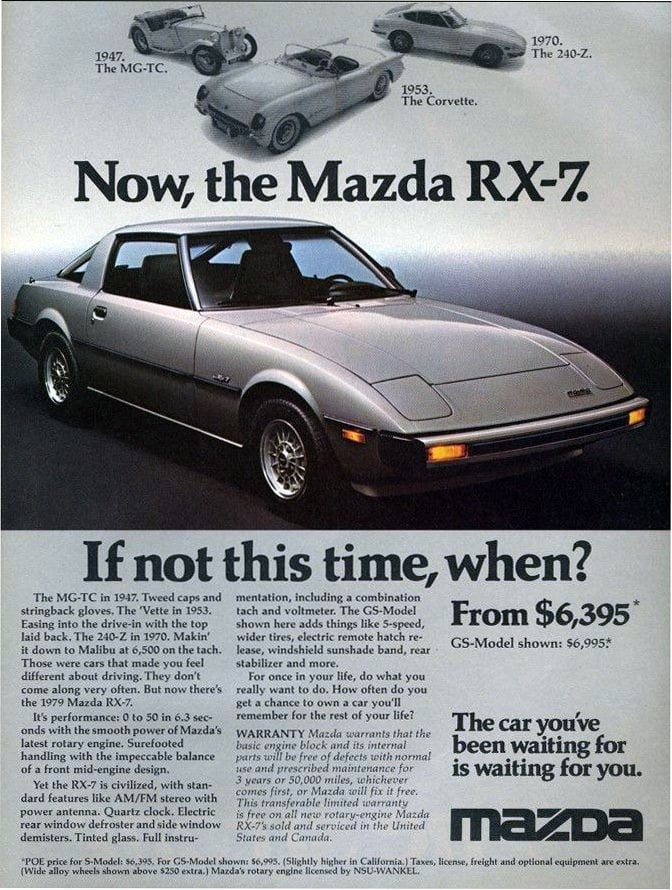
The Second Generation Mazda RX-7 FC
(Series 4 1985-1988, Series 5 1989-1992)
Where the First Generation Mazda RX-7 Savannah had been created as a pure sports car and used the Lotus Elan as its inspiration, the Second Generation moved away from that and shifted its inspiration to that of the Porsche 924 and 944.
The vast bulk of Mazda RX-7 sales had been to the United States market and so Mazda’s Chief Project Engineer Akio Uchiyama, took some members of his design team to the United States to study what it had been that had encouraged sales, and what was believed to be the changes that could be made that would consolidate and improve on sales.
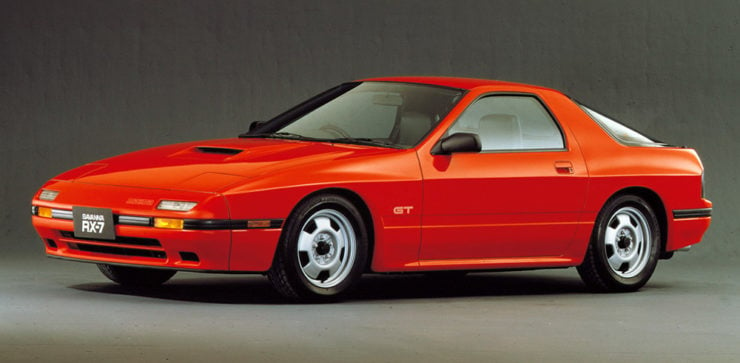
It had been the observation that buyers tended to admire the Porsche 924 and 944, whereas they often would never have heard of the Lotus Elan, that leaned Uchiyama and his team to aim for some changes to the styling of the Second Generation RX-7, and to look for ways to increase the power to cope with the weight that would be added by providing more luxurious fittings.
In order to actually be competitive with the Porsches the Second Generation RX-7 was going to need some refinements of its steering and suspension. The worm and roller steering was done away with and replaced with the much preferred rack and pinion, while at the rear the multi-link and Watts Linkage beam axle was replaced with a fully independent system, something that the RX-7’s competitor, the Datsun 240Z and its siblings, had possessed from the outset.
Not only did the Second Generation RX-7 provide a fully independent suspension but it also added the sophistication of the Dynamic Tracking Suspension System (DTSS) which provided passive limited rear wheel steering to give added directional stability in a straight line and more neutral handling in corners.
The directional stability was created by giving the rear wheels a small degree of toe-out with this being maintained in gentle cornering. Under heavy cornering, with forces up around 0.5g or greater the system switched to a slight toe-in condition to balance any tendency towards oversteer, something the First Generation cars had been known for.
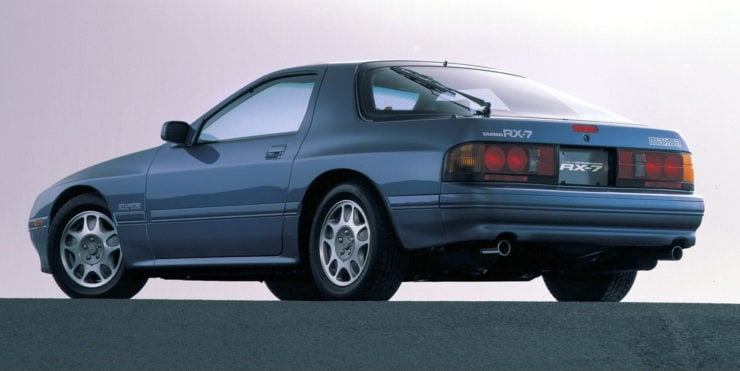
In addition to the sophistication of the DTSS, the FC generation RX-7 also introduced an Auto Adjusting Suspension (AAS) system. This system automatically changed the car’s damping characteristics to suit the road conditions by providing anti-dive and anti-squat as well as compensation for changing camber conditions.
The additional power to propel the additional 800lb weight of the new car was provided by a fuel injected 13B-VDEI twin rotor engine delivering 146hp in its North American
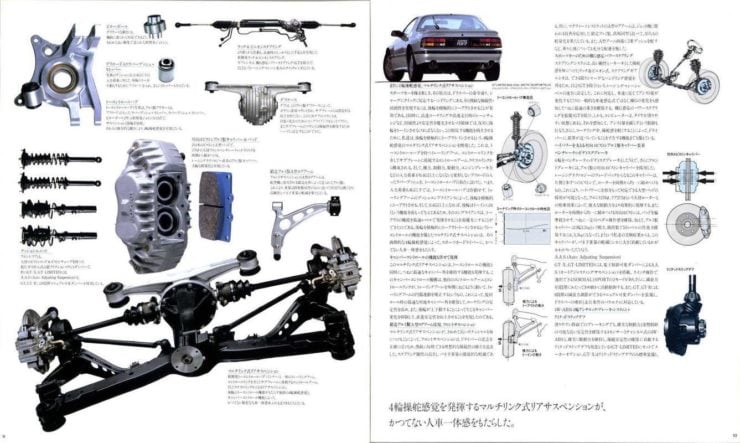
The turbocharger for these cars featured a “twin scroll” design, used to alleviate turbo-lag. In this the turbocharger was provided with two chambers, a smaller primary chamber, and a larger secondary chamber: this being done to provide a more immediate boost from the smaller chamber while the larger chamber would open up at higher revolutions. This unit was also provided with an air-to-air intercooler.
Despite being a heavier car and its providing a comfort oriented driving experience, and therefore feeling a bit more detached, these RX-7 FC generation cars were well liked both by the buying public and by the motoring press. It was only in Australia that the need to return to the lighter more Lotus like handling of the First Generation cars seems to have been felt.
To this end Australian Motors Mazda created a special limited edition 250 Sports model which was stripped of power steering, power windows, and even the rear window wiper, in an effort to lose some of that 800lb (363kg) of added weight.

Just as there were option packages and limited edition cars for the First Generation so this also followed onto the Second Generation cars. The unusually named “ɛ̃fini” for the Japanese market was limited to 600 cars per year and included various upgrades of such things as the Engine Control Unit (ECU), suspension, special aluminum alloy wheels, bonnet scoop and other bodywork enhancements including the “ɛ̃fini” badgework.
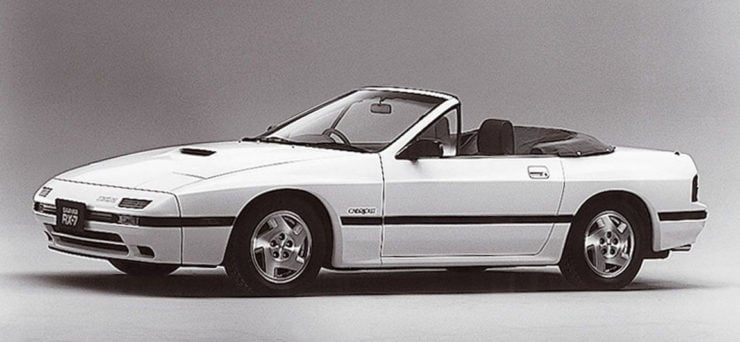
1988 saw the introduction of an RX-7 convertible. The soft top was a remarkable design being made as a unit and power operated. The convertible top featured a heated rear glass and a unique rigid panel that came up behind the passenger seats to prevent drafts from the rear of the car reaching passengers when the top was down, making it possible to drive the car with the top down in cool to cold weather.
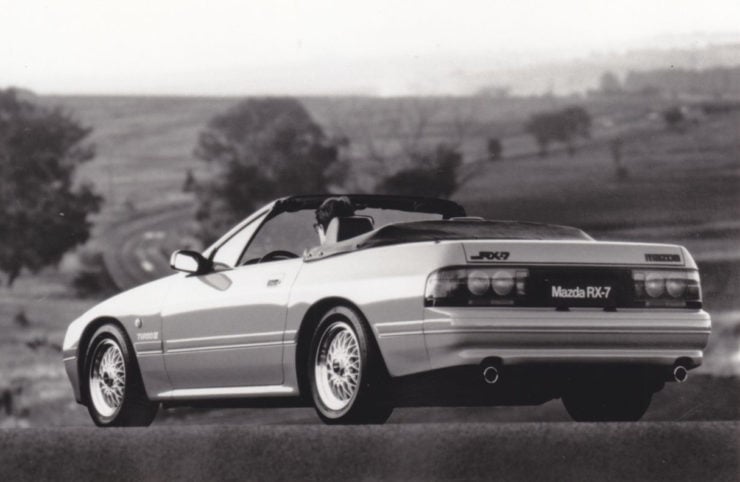
Two other special editions worthy of note were the 10th Anniversary Edition of 1998 and the GTUs which were made between 1989 to 1990. The 10th Anniversary model was based on the Turbo II with a Crystal White paint scheme with white 16″ alloy seven spoke wheels, white body moldings and tail light housings. To contrast with the whiteness was a black interior and black leather wrapped Momo steering wheel and gearlever knob, with “10th Anniversary Edition” on the wheel boss as one would expect.
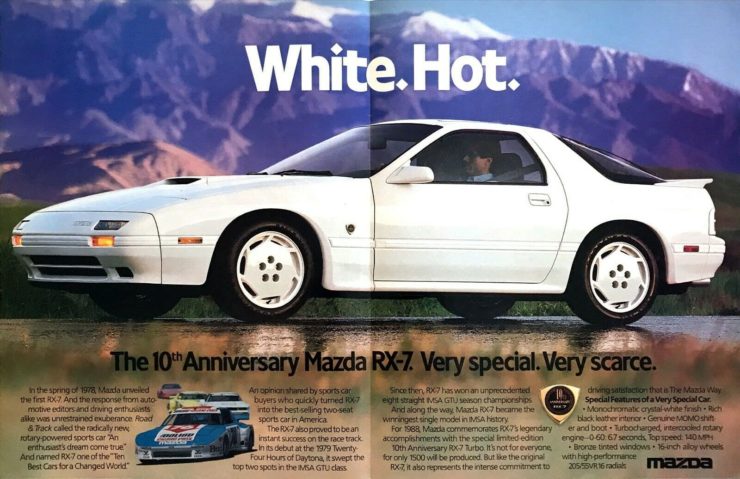
With the RX-7 doing so well in motor sport Mazda decided to create a lightened version of the RX-7, in some respects similar to the idea behind the Australian special version. Like the Australian lightweight model this “GTUs” model had ordinary wind-up windows, and no rear window wiper. The car was fitted with a conventionally aspirated 13B engine but was fitted with high performance options such as the ventilated front and rear discs used on the turbocharged models along with four pot front calipers and a 4.300 type viscous limited slip differential which did not appear on any other model.
The RX-7 GTUs was fitted with 16″ wheels shod with 205/55VR tires and also had speed sensing power steering so that the driver would have excellent feel for the rack and pinion steering in normal driving, but power assistance for close maneuvering. In all 1,100 of these cars were made, 1,000 in 1989 and the last 100 in 1990.
The Third Generation Mazda RX-7 “FD” (1992-2002)
(Series 6 1992-1995, Series 7 1996-1998, Series 8 1998-2002)
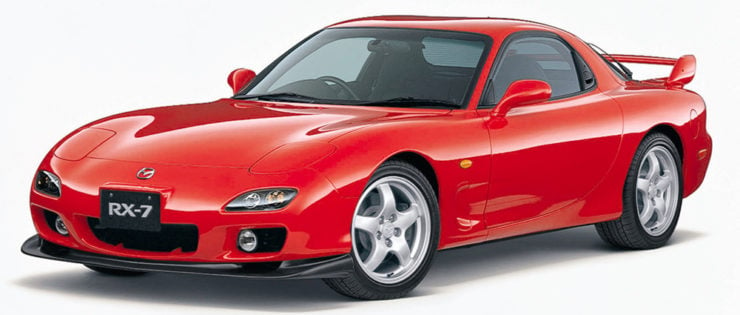
The Third Generation FD Mazda RX-7 marked a departure from the original concept, that of being a small enough car to remain below the size and engine capacity ceiling to avoid the need to pay Japanese taxes. The new RX-7 was below the engine capacity threshold, but not that for physical size, particularly its width. This made it a luxury sports car in Japan with the inherent additional costs that imposed.
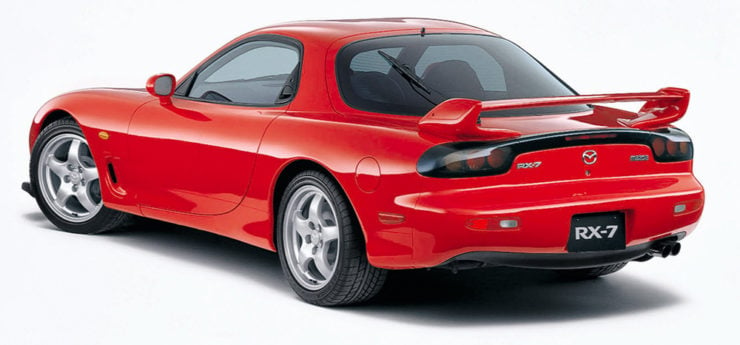
To fill the small sporty car gap left vacant by the RX-7’s move into the luxury class Mazda created the small MX-5 roadster and the MX-3 coupe, both only fitted with piston engines, not rotary. In a sense this marked the writing on the wall for the future of Mazda rotary power, it was phased into the most expensive models in their product line-up, and ultimately the rotary would be phased out as the RX-7 and RX-8 ended production along with the other high performance rotary engine models, such as the final model of the Mazda Cosmo.
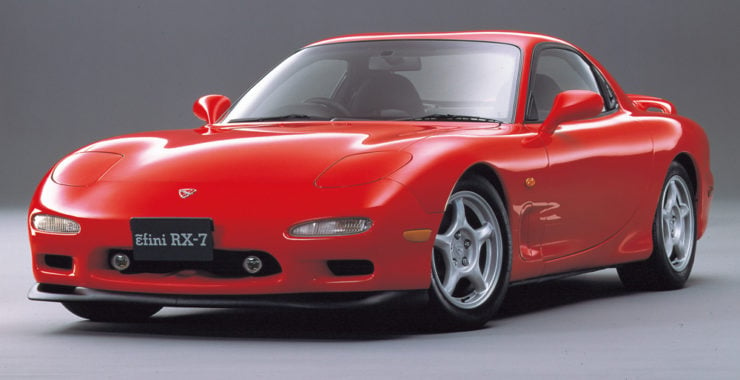
For the Japan domestic market the RX-7 was sold under the prestigious “ɛ̃fini” brand name to set it apart from the ordinary Mazda products. The model was made with a twin turbocharged twin rotor 13B-REW engine. This engine used a sequential twin turbocharging system which Mazda had developed in collaboration with Hitachi. The other Mazda car it was used in was the high performance Cosmo JC Series.
This sequential twin turbocharging system used a first turbocharger to deliver around 10psi boost from around 1,800rpm. The second turbocharger would not come in to play unless the engine was under high throttle and the engine speed had attained 4,000rpm and above, it would then activate to maintain 10psi boost at that much higher engine speed up to the redline, with the second turbocharger effectively taking over the delivery of engine boost from 4,500rpm on up.
The system operated almost seamlessly, with a slight drop in boost pressure to 8psi around the 4,500rpm changeover point. Thus the engine was maintained at a consistent delivery of power and torque all the way through its rev range. The engines of the Series 6 cars from 1992-1993 produced 252hp with 217lb/ft of torque, and this power output would be increased to 276hp with 231lb/ft of torque by 2002, when the Series 8 cars ended production.
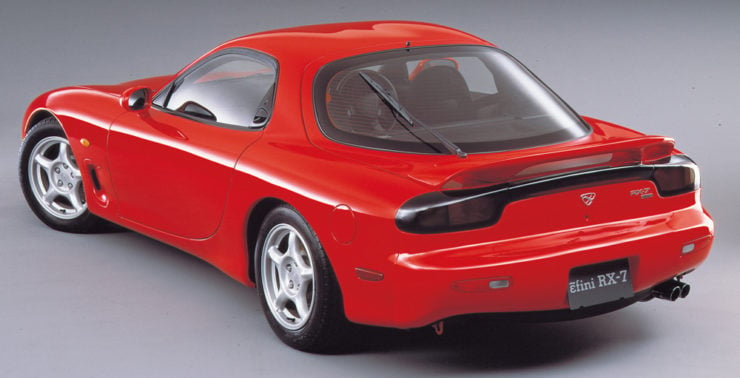
In Japan the ɛ̃fini RX-7 was made as the base model Type S, the lightweight sporting model the Type R, and the Type RZ, Type RB, A-spec and the Touring X equipped with a four speed automatic transmission.
For the North American market the Mazda RX-7 was offered in base model, the R models, and the Touring with automatic transmission. The touring model was equipped for its purpose with fog lights, sunroof, Bose acoustic wave sound system, rear window wiper, and nice comfy leather seats for those long hours on the road.
The R models (R1 and R2) were performance oriented with stiffer suspension, Bilstein shock absorbers, an oil cooler, aerodynamics body package with a front air dam and rear wing type spoiler, and the seats were nice suede to allow sweaty skin to breathe while maintaining a grip to ensure the driver did not slide around under enthusiastic cornering.
From 1996-1998 a group of updated models known as the Series 7 cars were produced only in right hand drive for markets in Japan, Australia, New Zealand and Britain. These cars had a 16 bit ECU with improved intake and manifold vacuum routing giving these cars an increase in power of about 10hp for manual transmission vehicles. These cars were marketed under both Mazda and ɛ̃fini brand names depending on the market.
The final cars of the Third Generation FD Mazda RX-7 were the Series 8 cars, made between 1998-2002 and this model variant was exclusively made for the Japan Domestic Market.
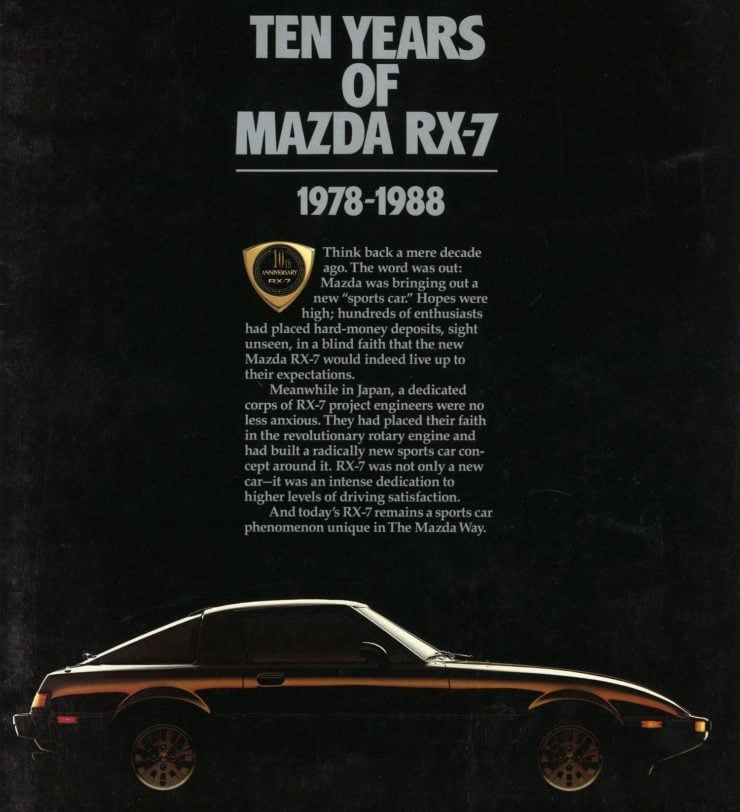
The Series 8 cars were the last of the line for the Mazda RX-7. The car that had begun inspired by the Lotus Elan of the 1960’s and 1970’s had gone on to become a world class sports car with an impressive array of motorsport accomplishments to its credit. It retained the front mid-engine layout throughout its life and its intelligent Japanese engineering kept it at the head of the pack, a technology leader, and a superb car to drive.
The sophisticated technology of the FD Third Generation of cars means that they need sophisticated maintenance in order to keep them operating flawlessly and there are owners who have discovered that information the hard way, oftentimes from purchasing one of these cars second hand and subsequently finding that the maintenance that was needed had been lacking.
These sorts of dynamics have led to the later RX-7’s gaining an reputation for unreliability, a reputation that is arguably not deserved: if you want to own a sophisticated high technology car then you need to invest in high level maintenance to keep it working perfectly. If you want a car that needs little maintenance then you should of course buy something conventional and non-demanding. The RX-7 is a racehorse of a car, so expect that the “Vet” bills are going to be a significant outlay. There’s an old saying that claims “The best things in life are free”, its not true. Typically the best things in life are going to cost you.
The RX-7 in Motorsport
Mazda were determined to prove the rotary engine in motorsport, realizing that this was key to having it gain widespread acceptance. Their great success was with their four rotor 787B sports racing car that won the prestigious 24 Hours Le Mans in 1991, and becoming the first Japanese car to achieve this.
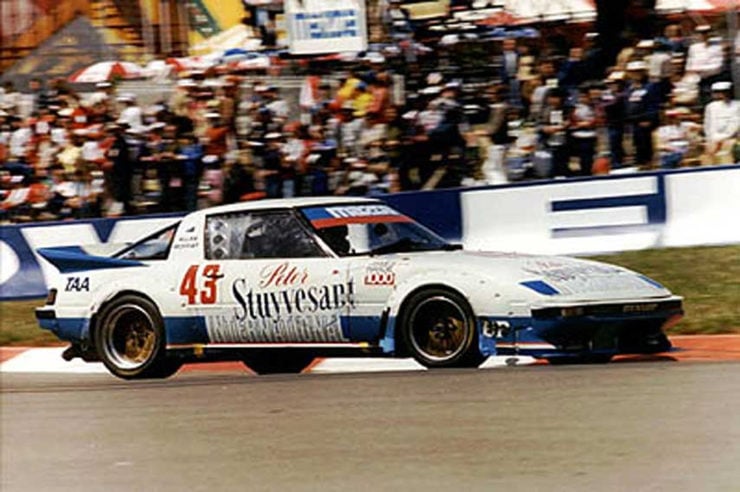
The RX-7 was entered in the IMSA GTU class in the 24 Hours Daytona and managed a first and second, going on to obtain the championship in this series for seven consecutive years. In 1981 the little RX-7 went to the Spa 24 Hours race and won.
The RX-7 also made its way “down under” to Australia where Canadian born driver Alan Moffat began campaigning the car in the Australian Touring Car Championships gaining victory in 1983, along with three podium places in the Bathurst 1000 race which was held on the demanding Mount Panorama circuit. Mazda would later name two of its Series 8 RX-7 models after the Bathurst circuit, the Type R Bathurst, and the Type R Bathurst R.
Conclusion
The Mazda RX-7 stands out as one of very few successful cars powered by a Wankel rotary engine. Mazda committed to a “make or break” effort to create a name for their company based on rotary engine technology, and where German company NSU and French company Citroën did not succeed Mazda did: and that was a feat of epic proportions. The RX-7 was the sports car created out of that technological effort and it turned out to be one of the greatest sports cars ever created because of the unique characteristics of the rotary engine that especially suit a sports car or a touring car.
Will we see a return to rotary engine technology by Mazda or is that season now at an end? No-one really knows the answer to that question at this stage. It may be that Mazda has established its name and credentials such that it does not need to take another gamble on rotary engine technology, at least not yet at this time in history. As it now is Mazda’s RX-7 stands out as a legendary sports cars that has earned its place in automotive history, it is an icon of the 1980’s and 1990’s.
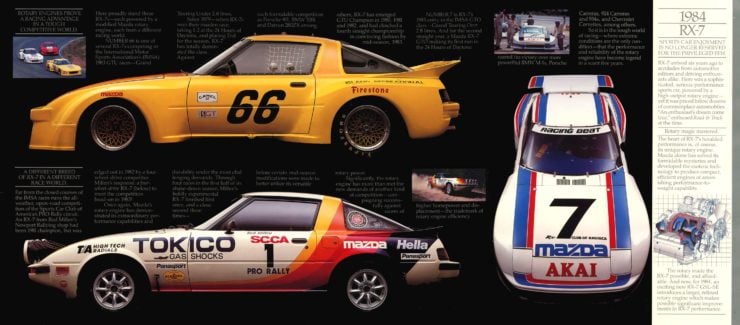
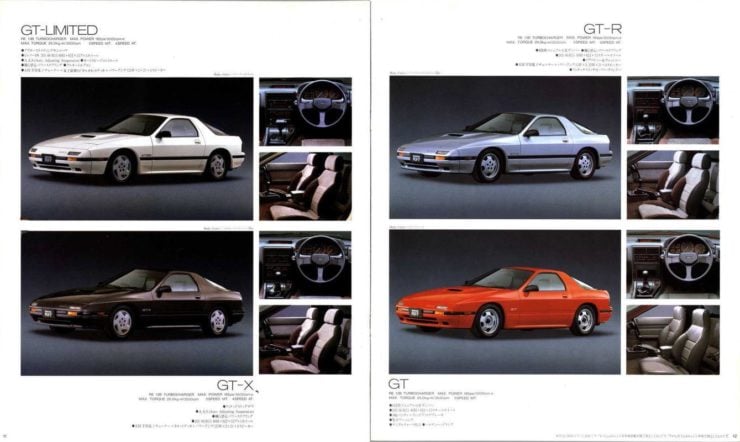
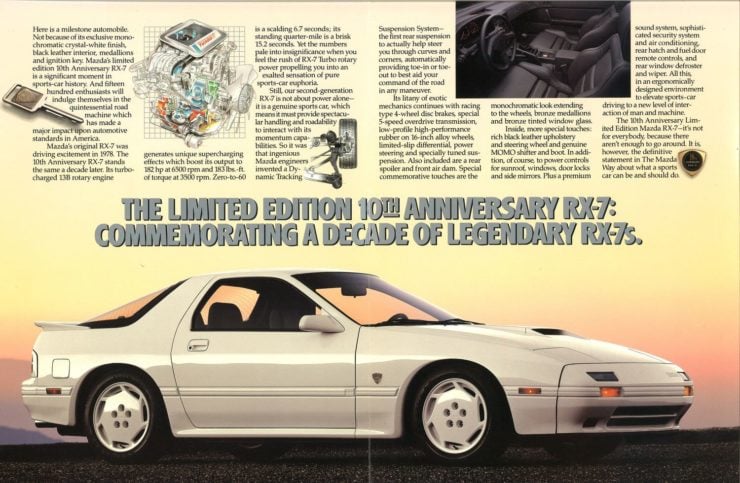
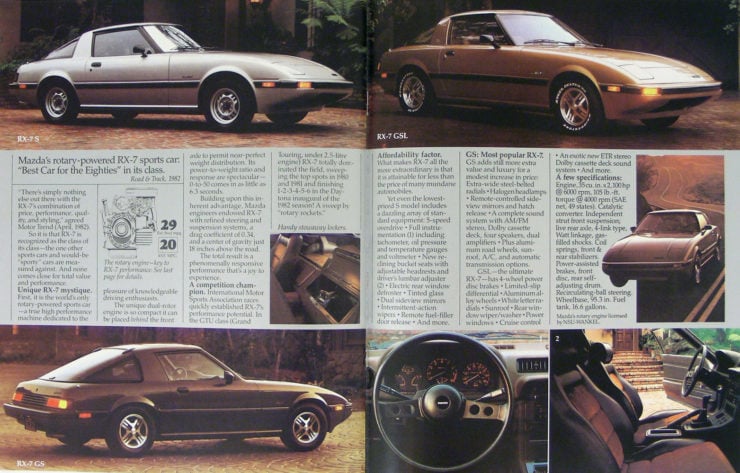
Photo Credits: Mazda.

